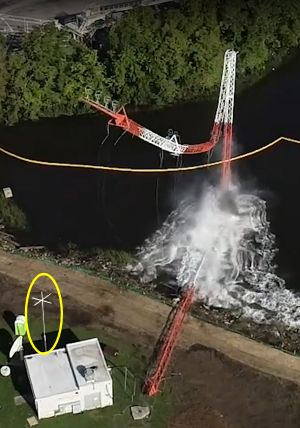
| Tower Down! | ||
| Norfolk's WJOI Maintains Operations with Quick Switch to New HPR.0990 AM Antenna | ||
 | ||
| That was close! Dramatic footage of WJOI/WNOR radio tower collapsing into Chesapeake Bay. The station’s temporary AM antenna is clearly visible (circled). Watch the video below. | ||
| NORFOLK, VA: The salty ocean breeze that blows past the antenna tower of WJOI Radio in Virginia finally won. Standing valiantly beside the sea since 1973, the corrosion finally compromised, and engineers told the owner that they had no choice but to let it topple into Chesapeake Bay. Demolition happened Saturday, September 14th. See the video. But keeping the 1230 AM WJOI signal on the air at 1/4 power during the next 4 months, while the replacement tower is constructed, could have been a tricky and expensive proposition. Saga Communications’ Tom Atkins observes: “It was problematic to find a suitable [alternate] location to operate WJOI-AM from temporally.” But Atkins was able to leverage his association with Information Station Specialists to obtain the company’s first production model of their new HPR.0990 High Performance AM Antenna so they could continue operations from the same site. | ||
| ||
| Attached to a temporary mast lashed to the station’s transmitter shack, the antenna is currently handling the 157 watts of power, allowed by the FCC under a Special Temporary Operating Authority (STA). The newly designed antenna is unique in its ability to handle hundreds of AM watts, while not requiring a tower, an elaborate foundation or climbing-labor to install. The savings to Saga Communications – both in time and equipment costs – was significant compared to other alternatives they had for maintaining the service. States Atkins: “The HPR-0990, with its 300-watt power handling capability and its efficient cost, was the perfect solution to continue operation from the existing transmitter location under an FCC STA while the new tower is being constructed.” | ||
 | ||
| The damaging effect of salt air on metal, as illustrated by a speed limit sign near the WJOI antenna site. | ||
| When WJOI’s new broadcast tower is completed and power is restored to 630 watts, Saga Communications has the option to use the HPR.0990 Antenna again, should it be needed as an auxiliary. The new HPR.0990 Antenna will allow an AM broadcaster to utilize his main transmitter – at reduced levels – to produce a much larger temporary coverage footprint than would be possible with previously available whip antennas, such as Information Station Specialists’ standard “ANXX” antenna, which is limited to 25 watts. Yet, for some station owners, the lower capacity antenna solution remains ideal. Example: In Atlanta, WYZE AM 1480 has been dark for several months, having lost access to their licensed tower site. New owner New Ground Broadcasting plans to begin operating soon on a STA with 10 watts using a temporary kit provided by Information Station Specialists that consists of a low power transmitter, the ANXX antenna on a temporary stand and a quick-deploy groundplane. The short-term operation will commence from a building roof, adjacent to the station’s newly acquired transmitter location. Email here to request more information about the HPR.0990 or ANXX antenna solutions. |
PO Box 51, Zeeland, Michigan, USA, 49464-0051, Phone 616.772.2300, Email
• • •